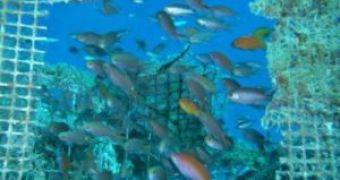Aquaculture arose as an effort of increasing sea and freshwater productivity, especially after the '60s, when fish prices grew and wild stocks decreased greatly.
2500 years ago, Chinese people hold carps in artificial lakes, fed with waste products from silk production: nymphs and feces of silkworms. The Japanese practiced cultivation of seaweed by providing bamboo poles and, later, nets and oyster shells to serve as anchoring surfaces for spores.
The first modern experiences of aquaculture started when researchers sank in the sea water at 10-80 (30-250 feet) depths solid structures, generating artificial reefs.
First, the structures were made of bamboo and as ballast were used sand sacks.
After that, concrete structures of thousands of meters were used, with a volume of thousands of cubic meters, serving as habitat for marine flora and fauna. This led to a 20 times increase of the production.
When researchers dropped off near a natural reef 500 assembled used tires, after seven months they were populated by the same number of species as the neighboring natural reef and after one year the biomass doubled.
The fact is explainable as such structures protect water life during their movements along the sea coasts and while mating, and the artificial reefs serve as sustentation for algae, mollusks and crustaceans.
In other experiments, the researchers sank automobile chassis at 15 m (45 feet) depths with excellent results. Also, scientists investigated the placement of floating installations compassing about 30,000 cavities.
Other experiments used structures made of steel grills covered with wastes which could be sunk in seas and rivers. This way an aquaculture farm was created from octagonal cages which can float or sink. They can be transported on the sea by tugboats to a suitable place for growing fish, where they are anchored.
Floating basins are already used in mountain lakes for trout farming in Romania.
Scientists found that a hectare of artificial reefs or floating basins can produce - through aquaculture - 250 tonnes of fish, using 1.5 kg fish food for 1 kg of live fish (for farm meat 4 kg of food are necessary to produce 1 kg of meat).
Scientists also imagined methods of cultivating crops using floating platforms on the sea, employing salt-tolerant plants like sugar beet.
In a polystyrene panel, which allowed water vapors to pass, a nutritive substratum made of peat and fertilizers was placed. The seeds germinated in 8 days and even at only 8 mm of rainfall in the first three weeks, the seedlings developed normally, as condensation of the vapors formed at the sea surface compensated the indispensable water needs.

 14 DAY TRIAL //
14 DAY TRIAL //